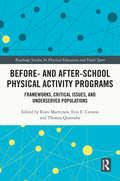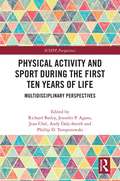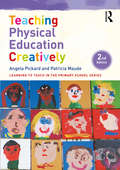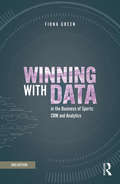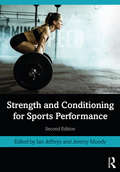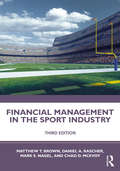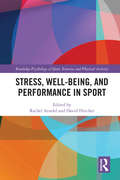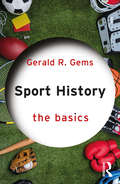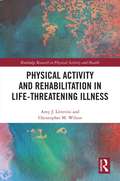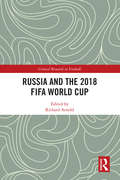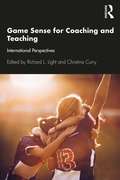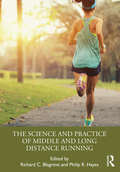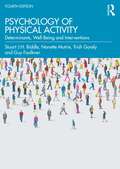- Table View
- List View
Before and After School Physical Activity Programs: Frameworks, Critical Issues and Underserved Populations (Routledge Studies in Physical Education and Youth Sport)
by Risto Marttinen Erin E. Centeio Thomas QuarmbyThis is the first book to offer a critical examination of the delivery of before and after-school physical activity programs, from global perspectives. It introduces key theory and best practice in before and after-school physical activity research and programming, and is an essential resource for educators involved in the design and implementation of after-school programs. With contributions from leading international researchers and practitioners in the field of health and physical education, the book provides an overview of research methods in before and after-school physical activity. It offers insight on theoretical frameworks and the implementation of programs as they relate to policy in schools, as well as an overview of social and emotional learning in after-school programs. The book also explores inclusive before and after-school physical activity programming for underserved communities, covering key topics from Positive Youth Development and urban programming to developing adult leaders and working with LGBTQI populations and children with disabilities. This book is important reading for researchers in health and physical education, and policy-makers, teachers, youth workers and coaches working with children in physical education, health education, physical activity or sport.
Before and After School Physical Activity Programs: Frameworks, Critical Issues and Underserved Populations (Routledge Studies in Physical Education and Youth Sport)
by Risto Marttinen Erin E. Centeio Thomas QuarmbyThis is the first book to offer a critical examination of the delivery of before and after-school physical activity programs, from global perspectives. It introduces key theory and best practice in before and after-school physical activity research and programming, and is an essential resource for educators involved in the design and implementation of after-school programs. With contributions from leading international researchers and practitioners in the field of health and physical education, the book provides an overview of research methods in before and after-school physical activity. It offers insight on theoretical frameworks and the implementation of programs as they relate to policy in schools, as well as an overview of social and emotional learning in after-school programs. The book also explores inclusive before and after-school physical activity programming for underserved communities, covering key topics from Positive Youth Development and urban programming to developing adult leaders and working with LGBTQI populations and children with disabilities. This book is important reading for researchers in health and physical education, and policy-makers, teachers, youth workers and coaches working with children in physical education, health education, physical activity or sport.
Physical Activity and Sport During the First Ten Years of Life: Multidisciplinary Perspectives (ICSSPE Perspectives)
by Richard Bailey Phillip D. Tomporowski Jean Côté Jennifer P. Agans Andy Daly-SmithEvidence suggests that the first 10 or so years of life create the foundation for subsequent participation in recreational and health-related physical activity. This book brings together researchers and practitioners with expertise in issues related to physical activity, physical education, and sport during the primary/elementary phase of schooling, to explore these important issues. Combining inter-disciplinary perspectives, the book addresses the inherent complexity of researching with young children. It looks at the evidence on development during the first 10 years and how that evidence relates to physical activity and to sport, in pre-school, school and out of school. Finally, the book offers a series of national case studies, from Asia, Europe and Africa, demonstrating the importance of age-appropriate sport and physical activity. This is important reading for any student, researcher, educator or policy maker with an interest in physical activity and health, education in the early years or at primary/elementary level, paediatric exercise science, or youth sport.
Physical Activity and Sport During the First Ten Years of Life: Multidisciplinary Perspectives (ICSSPE Perspectives)
by Bailey RichardEvidence suggests that the first 10 or so years of life create the foundation for subsequent participation in recreational and health-related physical activity. This book brings together researchers and practitioners with expertise in issues related to physical activity, physical education, and sport during the primary/elementary phase of schooling, to explore these important issues. Combining inter-disciplinary perspectives, the book addresses the inherent complexity of researching with young children. It looks at the evidence on development during the first 10 years and how that evidence relates to physical activity and to sport, in pre-school, school and out of school. Finally, the book offers a series of national case studies, from Asia, Europe and Africa, demonstrating the importance of age-appropriate sport and physical activity. This is important reading for any student, researcher, educator or policy maker with an interest in physical activity and health, education in the early years or at primary/elementary level, paediatric exercise science, or youth sport.
Teaching Physical Education Creatively (Learning to Teach in the Primary School Series)
by Angela Pickard Patricia MaudeThis fully updated second edition of Teaching Physical Education Creatively provides knowledge and understanding for students, trainee and qualified teachers, to engage creatively in teaching primary Physical Education. It is full of ideas for developing the teaching of dance, games, gymnastics and ways of using outdoor spaces for activities in an innovative and engaging manner. There is also a chapter to support creative practitioner to plan for creative Physical Education. With an emphasis on developing creative teaching processes by building from children’s curiosity, imagination and need to explore and move, it forges clear links between research and practice, and offers suggestions for developing exciting, engaging new approaches to teaching Physical Education. Key topics explored include: Physical Education and creativity Building physical competence and physical literacy Creative ways to develop the teaching of dance, games, gymnastics and ways of using outdoor spaces for activities Developing understanding of space, speed and dynamics Creative planning Inclusive approaches and aspects of differentiation Teaching Physical Education Creatively presents the theory and background necessary to develop a comprehensive understanding of creative teaching and children’s learning. Packed with practical guidance and inspiration for lively, enjoyable Physical Education, it is an invaluable resource for undergraduate and postgraduate students in initial teacher training, practicing teachers, and undergraduate students of Physical Education and dance.
Teaching Physical Education Creatively (Learning to Teach in the Primary School Series)
by Angela Pickard Patricia MaudeThis fully updated second edition of Teaching Physical Education Creatively provides knowledge and understanding for students, trainee and qualified teachers, to engage creatively in teaching primary Physical Education. It is full of ideas for developing the teaching of dance, games, gymnastics and ways of using outdoor spaces for activities in an innovative and engaging manner. There is also a chapter to support creative practitioner to plan for creative Physical Education. With an emphasis on developing creative teaching processes by building from children’s curiosity, imagination and need to explore and move, it forges clear links between research and practice, and offers suggestions for developing exciting, engaging new approaches to teaching Physical Education. Key topics explored include: Physical Education and creativity Building physical competence and physical literacy Creative ways to develop the teaching of dance, games, gymnastics and ways of using outdoor spaces for activities Developing understanding of space, speed and dynamics Creative planning Inclusive approaches and aspects of differentiation Teaching Physical Education Creatively presents the theory and background necessary to develop a comprehensive understanding of creative teaching and children’s learning. Packed with practical guidance and inspiration for lively, enjoyable Physical Education, it is an invaluable resource for undergraduate and postgraduate students in initial teacher training, practicing teachers, and undergraduate students of Physical Education and dance.
Winning with Data in the Business of Sports: CRM and Analytics
by Fiona GreenNew technologies mean that sports clubs and governing bodies are generating more data than ever to help manage their relationship with fans, their performance, and their income streams. This new edition of Winning with Data in the Business of Sports explains how to acquire, store, maintain, and use data in the most effective ways. The key developments are three-fold: new technology, new understanding of how to apply that technology, and the new laws informing and controlling the data that can be generated from the technology. Important developments that have occurred since the publication of the first edition include the General Data Protection Regulations (GDPR) and the COVID-19 pandemic. With a focus on these unique challenges coupled with the opportunities the use of data creates, this book is essential reading for professionals within the sports industry. This second edition includes: - An introduction to new technologies, the data they generate, and the supporting processes we need to have in place to use them. - Brand new case studies with recent examples of creative applications from clubs, teams, leagues, and governing bodies, including Arsenal, AS Roma, ICC Cricket World Cup, LA Kings, Portland Trail Blazers, and UEFA. - The sports industry’s response to tighter data legislation introduced primarily though the GDPR. - The role of data and direct engagement during the COVID-19 pandemic. The book provides clear guidance and knowledge that sports industry professionals need to understand the role of data for the business side of sports. It is essential reading for sports clubs, governing bodies and those working in sports marketing, media and communications, sponsorship, merchandise, ticketing, events, and participation development. The book will also be of interest to students of sports management.
Winning with Data in the Business of Sports: CRM and Analytics
by Fiona GreenNew technologies mean that sports clubs and governing bodies are generating more data than ever to help manage their relationship with fans, their performance, and their income streams. This new edition of Winning with Data in the Business of Sports explains how to acquire, store, maintain, and use data in the most effective ways. The key developments are three-fold: new technology, new understanding of how to apply that technology, and the new laws informing and controlling the data that can be generated from the technology. Important developments that have occurred since the publication of the first edition include the General Data Protection Regulations (GDPR) and the COVID-19 pandemic. With a focus on these unique challenges coupled with the opportunities the use of data creates, this book is essential reading for professionals within the sports industry. This second edition includes: - An introduction to new technologies, the data they generate, and the supporting processes we need to have in place to use them. - Brand new case studies with recent examples of creative applications from clubs, teams, leagues, and governing bodies, including Arsenal, AS Roma, ICC Cricket World Cup, LA Kings, Portland Trail Blazers, and UEFA. - The sports industry’s response to tighter data legislation introduced primarily though the GDPR. - The role of data and direct engagement during the COVID-19 pandemic. The book provides clear guidance and knowledge that sports industry professionals need to understand the role of data for the business side of sports. It is essential reading for sports clubs, governing bodies and those working in sports marketing, media and communications, sponsorship, merchandise, ticketing, events, and participation development. The book will also be of interest to students of sports management.
Strength and Conditioning for Sports Performance
by Ian Jeffreys Jeremy MoodyAn effective strength and conditioning program is an essential component of the preparation of any athlete or sportsperson. Strength and Conditioning for Sports Performance is a comprehensive and authoritative introduction to the theory and practice of strength and conditioning, providing students, coaches and athletes with everything they need to design and implement effective training programs. Revised and updated for a second edition, the book continues to include clear and rigorous explanations of the core science underpinning strength and conditioning techniques and give detailed, step-by-step guides to all key training methodologies, including training for strength, speed, endurance, flexibility and plyometrics. The second edition expands on the opening coaching section as well as introducing an entirely new section on current training methods which includes examining skill acquisition and motor learning. Throughout the book the focus is on the coaching process, with every chapter highlighting the application of strength and conditioning techniques in everyday coaching situations. Strength and Conditioning for Sports Performance includes a unique and extensive section of sport-specific chapters, each of which examines in detail the application of strength and conditioning to a particular sport, from soccer and basketball to golf and track and field athletics. The second edition sees this section expanded to include other sports such as rugby union, rugby league and American football. The book includes contributions from world-leading strength and conditioning specialists, including coaches who have worked with Olympic gold medallists and international sports teams at the highest level. Strength and Conditioning for Sports Performance is an essential course text for any degree-level student with an interest in strength and conditioning, for all students looking to achieve professional accreditation, and an invaluable reference for all practising strength and conditioning coaches.
Strength and Conditioning for Sports Performance
by Ian Jeffreys and Jeremy MoodyAn effective strength and conditioning program is an essential component of the preparation of any athlete or sportsperson. Strength and Conditioning for Sports Performance is a comprehensive and authoritative introduction to the theory and practice of strength and conditioning, providing students, coaches and athletes with everything they need to design and implement effective training programs. Revised and updated for a second edition, the book continues to include clear and rigorous explanations of the core science underpinning strength and conditioning techniques and give detailed, step-by-step guides to all key training methodologies, including training for strength, speed, endurance, flexibility and plyometrics. The second edition expands on the opening coaching section as well as introducing an entirely new section on current training methods which includes examining skill acquisition and motor learning. Throughout the book the focus is on the coaching process, with every chapter highlighting the application of strength and conditioning techniques in everyday coaching situations. Strength and Conditioning for Sports Performance includes a unique and extensive section of sport-specific chapters, each of which examines in detail the application of strength and conditioning to a particular sport, from soccer and basketball to golf and track and field athletics. The second edition sees this section expanded to include other sports such as rugby union, rugby league and American football. The book includes contributions from world-leading strength and conditioning specialists, including coaches who have worked with Olympic gold medallists and international sports teams at the highest level. Strength and Conditioning for Sports Performance is an essential course text for any degree-level student with an interest in strength and conditioning, for all students looking to achieve professional accreditation, and an invaluable reference for all practising strength and conditioning coaches.
Financial Management in the Sport Industry
by Matthew T. Brown Daniel A. Rascher Mark S. Nagel Chad D. McEvoyNow in a fully revised and updated third edition, this essential textbook introduces the fundamentals of sport finance and sound financial management in the sport industry. It is still the only textbook to explain every aspect of finance from the perspective of the sport management practitioner, explaining key concepts and showing how to apply them in practice in the context of sport. The text begins by covering finance basics and the tools and techniques of financial quantification, using industry examples to apply the principles of financial management to sport. It then goes further, to show how financial management works specifically in the sport industry. Discussions include interpreting financial statements, debt and equity financing, capital budgeting, facility financing, economic impact, risk and return, time value of money, and more. The final part of the book examines financial management in four sectors of the industry: public sector sport, collegiate athletics, professional sport, and international sport. It provides an in-depth analysis of the mechanics of financial management within each of these sport sectors. Useful features, such as sidebars, concept checks, practice problems, case analysis and case questions will help students engage more deeply with financial techniques and encourage problem-solving skills. This new edition includes a completely new chapter on international sport, reflecting the globalized nature of the modern sport industry, as well expanded coverage of current issues such as digital media finance, recent legal cases affecting collegiate sport, and the central importance of collective bargaining. Financial Management in the Sport Industry is an essential textbook for any undergraduate or postgraduate course in sport finance, and an invaluable supplement to any course in sport business or sport management. It is also an important reference for all sport management practitioners looking to improve their understanding of finance. The book is accompanied by updated and expanded ancillary materials, including an instructor’s manual, PowerPoint slides, and an image bank.
Financial Management in the Sport Industry
by Matthew T. Brown Daniel A. Rascher Mark S. Nagel Chad D. McEvoyNow in a fully revised and updated third edition, this essential textbook introduces the fundamentals of sport finance and sound financial management in the sport industry. It is still the only textbook to explain every aspect of finance from the perspective of the sport management practitioner, explaining key concepts and showing how to apply them in practice in the context of sport. The text begins by covering finance basics and the tools and techniques of financial quantification, using industry examples to apply the principles of financial management to sport. It then goes further, to show how financial management works specifically in the sport industry. Discussions include interpreting financial statements, debt and equity financing, capital budgeting, facility financing, economic impact, risk and return, time value of money, and more. The final part of the book examines financial management in four sectors of the industry: public sector sport, collegiate athletics, professional sport, and international sport. It provides an in-depth analysis of the mechanics of financial management within each of these sport sectors. Useful features, such as sidebars, concept checks, practice problems, case analysis and case questions will help students engage more deeply with financial techniques and encourage problem-solving skills. This new edition includes a completely new chapter on international sport, reflecting the globalized nature of the modern sport industry, as well expanded coverage of current issues such as digital media finance, recent legal cases affecting collegiate sport, and the central importance of collective bargaining. Financial Management in the Sport Industry is an essential textbook for any undergraduate or postgraduate course in sport finance, and an invaluable supplement to any course in sport business or sport management. It is also an important reference for all sport management practitioners looking to improve their understanding of finance. The book is accompanied by updated and expanded ancillary materials, including an instructor’s manual, PowerPoint slides, and an image bank.
Stress, Well-Being, and Performance in Sport (Routledge Psychology of Sport, Exercise and Physical Activity)
by Rachel Arnold David FletcherStress, Well-Being, and Performance in Sport provides the first comprehensive and contemporary overview of stress in sport and its implications on performance and well-being. It explores how athletes’, coaches, and support staff’s performance can be enhanced while simultaneously optimizing their well-being in contemporary sport. Divided into four sections following the stress process, Stress, Well-Being, and Performance in Sport covers key topics including: Appraising and Coping with Stress in Sport Responses to and Outcomes of Stress in Sport Moderators of the Stress Process in Sport Stress management to Promote Thriving in Sport Bringing together theory and practice, each chapter discusses conceptual and theoretical issues, current research, and innovative practical implications. Written by scholars around the globe, Stress, Well-being, and Performance offers an international perspective. It is important reading for students, professionals working in the field of sport psychology, as well as coaches, athletes, and support staff.
Stress, Well-Being, and Performance in Sport (Routledge Psychology of Sport, Exercise and Physical Activity)
by Rachel Arnold David FletcherStress, Well-Being, and Performance in Sport provides the first comprehensive and contemporary overview of stress in sport and its implications on performance and well-being. It explores how athletes’, coaches, and support staff’s performance can be enhanced while simultaneously optimizing their well-being in contemporary sport. Divided into four sections following the stress process, Stress, Well-Being, and Performance in Sport covers key topics including: Appraising and Coping with Stress in Sport Responses to and Outcomes of Stress in Sport Moderators of the Stress Process in Sport Stress management to Promote Thriving in Sport Bringing together theory and practice, each chapter discusses conceptual and theoretical issues, current research, and innovative practical implications. Written by scholars around the globe, Stress, Well-being, and Performance offers an international perspective. It is important reading for students, professionals working in the field of sport psychology, as well as coaches, athletes, and support staff.
Sport History: The Basics (The Basics)
by Gerald R. GemsThis is a fundamental text for the study of sport history. It answers the ‘why,’ ‘how,’ and ‘what’ questions, introducing the key principles and practices of sport history and walking the reader through the fascinating stories, debates, issues, and national and international narratives that constitute the history of sport. The book provides an overview of the field and the various professional roles assumed by practitioners, such as researchers, academics, and public historians. It is brief, crisp, and to the point. The main general topics of interest within the field – gender, race, nationalism, religion, sport and leisure, and megaevents – are covered with introductory vignettes, stories of interest, a wide variety of theoretical frameworks, and relevant historiography in the most current and timely text of its kind. Each chapter provides a list of further readings for more in-depth study. Students are taught how to conduct research and present their findings in a variety of mediums, and teaching and publication tips are offered for educators. Sport History: The Basics is essential reading for any student on a sport-related degree course or with an interest in social and cultural history. It is also fascinating reading for anybody with a general interest in sport.
Sport History: The Basics (The Basics #8)
by Gerald R. GemsThis is a fundamental text for the study of sport history. It answers the ‘why,’ ‘how,’ and ‘what’ questions, introducing the key principles and practices of sport history and walking the reader through the fascinating stories, debates, issues, and national and international narratives that constitute the history of sport. The book provides an overview of the field and the various professional roles assumed by practitioners, such as researchers, academics, and public historians. It is brief, crisp, and to the point. The main general topics of interest within the field – gender, race, nationalism, religion, sport and leisure, and megaevents – are covered with introductory vignettes, stories of interest, a wide variety of theoretical frameworks, and relevant historiography in the most current and timely text of its kind. Each chapter provides a list of further readings for more in-depth study. Students are taught how to conduct research and present their findings in a variety of mediums, and teaching and publication tips are offered for educators. Sport History: The Basics is essential reading for any student on a sport-related degree course or with an interest in social and cultural history. It is also fascinating reading for anybody with a general interest in sport.
Physical Activity and Rehabilitation in Life-threatening Illness (Routledge Research in Physical Activity and Health)
by Amy J. Litterini Christopher M. WilsonThis book is a comprehensive summary of the recommendations for best practice, and current evidence, for physical activity and rehabilitation of functional deficits in individuals with end-stage diseases. While advances in technology have afforded us the opportunity to live longer lives, it has also demanded an expansion of focus of medical interventions towards palliative care to enhance the quality of life. Exercise and healthcare professionals must strive to broaden their perspectives to provide for the unique needs of these individuals, and to successfully engage with them, to achieve the most positive outcomes throughout the entire continuum of care. Healthcare providers play a critical role in advocating for care to allow individuals to remain physically active for as long as possible, even in the face of declining health. Finally, due to the increasing and progressively emergent healthcare utilization required by these individuals, a significant cost burden is experienced by healthcare systems, patients, families, and payers. There is evidence of substantial protective effects of physical activity, prevention, safety, and rehabilitative procedures to reduce hospital readmissions, reduce length of stay, and assist in avoiding unwarranted or unnecessary diagnostic tests or procedures. Physical activity has been proven to have a substantial impact and protective effects on virtually all medical conditions. During curative management, but especially during transitional phases to palliative care, other strategies need enhanced consideration to complement the existing plan of care and help to improve patient’s quality of life. Ideally, physical medicine would be at the forefront of allowing individuals to live their best life until the very end. Physical Activity and Rehabilitation in Life-threatening Illness is key reading for academics and policy makers in physical activity, international exercise, wellness and rehabilitation, and related disciplines, as well as research-focused clinicians in settings where patients with advanced illness are frequently encountered.
Physical Activity and Rehabilitation in Life-threatening Illness (Routledge Research in Physical Activity and Health)
by Amy J. Litterini Christopher M. WilsonThis book is a comprehensive summary of the recommendations for best practice, and current evidence, for physical activity and rehabilitation of functional deficits in individuals with end-stage diseases. While advances in technology have afforded us the opportunity to live longer lives, it has also demanded an expansion of focus of medical interventions towards palliative care to enhance the quality of life. Exercise and healthcare professionals must strive to broaden their perspectives to provide for the unique needs of these individuals, and to successfully engage with them, to achieve the most positive outcomes throughout the entire continuum of care. Healthcare providers play a critical role in advocating for care to allow individuals to remain physically active for as long as possible, even in the face of declining health. Finally, due to the increasing and progressively emergent healthcare utilization required by these individuals, a significant cost burden is experienced by healthcare systems, patients, families, and payers. There is evidence of substantial protective effects of physical activity, prevention, safety, and rehabilitative procedures to reduce hospital readmissions, reduce length of stay, and assist in avoiding unwarranted or unnecessary diagnostic tests or procedures. Physical activity has been proven to have a substantial impact and protective effects on virtually all medical conditions. During curative management, but especially during transitional phases to palliative care, other strategies need enhanced consideration to complement the existing plan of care and help to improve patient’s quality of life. Ideally, physical medicine would be at the forefront of allowing individuals to live their best life until the very end. Physical Activity and Rehabilitation in Life-threatening Illness is key reading for academics and policy makers in physical activity, international exercise, wellness and rehabilitation, and related disciplines, as well as research-focused clinicians in settings where patients with advanced illness are frequently encountered.
Russia and the 2018 FIFA World Cup (Critical Research in Football)
by Richard ArnoldDespite many negative expectations of the 2018 FIFA World Cup, Russia delivered one of the best World Cups in living memory. This book brings together leading scholars working in Russian studies, sociology and political science to analyse the 2018 World Cup and assess its significance for sport, Russia and the world. The book explores the connections between sport, soft power, populism, protest, and international politics, and investigates topics including security, surveillance, social media and patriotic mobilization, shining new light on key contemporary themes in the social sciences. It reflects upon the importance of sporting mega-events for public diplomacy, and considers what the 2018 World Cup can tell us about the current condition of Russian society and the Russian state. This is fascinating reading for anybody with an interest in soccer, sport and society, Russia, international politics, events, or post-Soviet societies.
Russia and the 2018 FIFA World Cup (Critical Research in Football)
by Richard ArnoldDespite many negative expectations of the 2018 FIFA World Cup, Russia delivered one of the best World Cups in living memory. This book brings together leading scholars working in Russian studies, sociology and political science to analyse the 2018 World Cup and assess its significance for sport, Russia and the world. The book explores the connections between sport, soft power, populism, protest, and international politics, and investigates topics including security, surveillance, social media and patriotic mobilization, shining new light on key contemporary themes in the social sciences. It reflects upon the importance of sporting mega-events for public diplomacy, and considers what the 2018 World Cup can tell us about the current condition of Russian society and the Russian state. This is fascinating reading for anybody with an interest in soccer, sport and society, Russia, international politics, events, or post-Soviet societies.
Game Sense for Teaching and Coaching: International Perspectives
by Richard L. Light Christina CurrySport coaching has grown significantly as an area of research interest with an expanding number of sport coaching programs offered. The past decade or so has also seen significant interest in games-based approaches to coaching and teaching games. On a global level, Game Sense is one of the most recognized athlete-centred approaches for team sports, probably close behind Teaching Games for Understanding. Game Sense for Coaching and Teaching provides an understanding of how an Australian approach to coaching has grown and developed as it has been taken up across the globe. While the focus is on Game Sense, the book also offers insights into how any coaching or physical education (PE) teaching approach changes as it is adapted to different contexts across the world, examining the theoretical, historical and philosophical foundations of sport coaching and teaching in schools. This book is particularly useful for undergraduate and post-graduate sport coaching and PE courses but is also likely to be of interest for all practicing sports coaches or physical education teachers and lecturers.
Game Sense for Teaching and Coaching: International Perspectives
by Richard L. Light and Christina CurrySport coaching has grown significantly as an area of research interest with an expanding number of sport coaching programs offered. The past decade or so has also seen significant interest in games-based approaches to coaching and teaching games. On a global level, Game Sense is one of the most recognized athlete-centred approaches for team sports, probably close behind Teaching Games for Understanding. Game Sense for Coaching and Teaching provides an understanding of how an Australian approach to coaching has grown and developed as it has been taken up across the globe. While the focus is on Game Sense, the book also offers insights into how any coaching or physical education (PE) teaching approach changes as it is adapted to different contexts across the world, examining the theoretical, historical and philosophical foundations of sport coaching and teaching in schools. This book is particularly useful for undergraduate and post-graduate sport coaching and PE courses but is also likely to be of interest for all practicing sports coaches or physical education teachers and lecturers.
The Science and Practice of Middle and Long Distance Running
by Richard C. Blagrove Philip R. HayesThe popularity of distance running as a sport, and a recreational activity, is at an all-time high. Motivated by the desire to achieve a personal best, remain healthy, or simply complete an event, distance runners of all ages and abilities actively seek out advice from experienced coaches and sport scientists. This is also reflected in the growth of programmes of education for young coaches and aspiring sport scientists in recent years. There are a multitude of different approaches to training distance runners; however, the basic principles and ingredients required for success are applicable to any distance runner. The science that underpins the training and physical preparation of distance runners has developed considerably in recent years. The most experienced and successful coaches in the distance running community rarely have the opportunity to share their tried and tested methods of training. Similarly, the novel work of sport scientists is often only accessible to elite runners, their support teams and academia. The Science and Practice of Middle and Long Distance Running links together the science and coaching artistry associated with preparing distance runners for events ranging from 800 m up to ultra-marathon distances. It combines the latest scientific evidence, published by world-leading sport scientists, with the sound training principles and strategies adopted by experienced coaches. The book translates cutting-edge scientific research from the fields of physiology, biomechanics, psychology and nutrition into practical suggestions for achieving success. Important topical issues and contemporary practices related to health and performance are also addressed. This book is an essential addition to the library of any distance runner, coach or sport scientist.
The Science and Practice of Middle and Long Distance Running
by Richard C. Blagrove; Philip R. HayesThe popularity of distance running as a sport, and a recreational activity, is at an all-time high. Motivated by the desire to achieve a personal best, remain healthy, or simply complete an event, distance runners of all ages and abilities actively seek out advice from experienced coaches and sport scientists. This is also reflected in the growth of programmes of education for young coaches and aspiring sport scientists in recent years. There are a multitude of different approaches to training distance runners; however, the basic principles and ingredients required for success are applicable to any distance runner. The science that underpins the training and physical preparation of distance runners has developed considerably in recent years. The most experienced and successful coaches in the distance running community rarely have the opportunity to share their tried and tested methods of training. Similarly, the novel work of sport scientists is often only accessible to elite runners, their support teams and academia. The Science and Practice of Middle and Long Distance Running links together the science and coaching artistry associated with preparing distance runners for events ranging from 800 m up to ultra-marathon distances. It combines the latest scientific evidence, published by world-leading sport scientists, with the sound training principles and strategies adopted by experienced coaches. The book translates cutting-edge scientific research from the fields of physiology, biomechanics, psychology and nutrition into practical suggestions for achieving success. Important topical issues and contemporary practices related to health and performance are also addressed. This book is an essential addition to the library of any distance runner, coach or sport scientist.
Psychology of Physical Activity: Determinants, Well-Being and Interventions
by Stuart J. Biddle Nanette Mutrie Trish Gorely Guy FaulknerThe positive benefits of physical activity for physical and mental health are now widely acknowledged, yet levels of physical inactivity continue to be a major concern throughout the world. Understanding the psychology of physical activity has therefore become an important issue for scientists, health professionals and policy-makers alike as they address the challenge of behaviour change. Psychology of Physical Activity provides comprehensive and in-depth coverage of the fundamentals of exercise psychology, from mental health, to theories of motivation and adherence, and to the design of successful interventions for increasing participation. Now publishing in a fully revised, updated and expanded fourth edition, Psychology of Physical Activity is still the only textbook to offer a full survey of the evidence base for theory and practice in exercise psychology, and the only textbook that explains how to interpret the quality of the research evidence. As the field continues to grow rapidly, the new edition expands the behavioural science content of numerous important topics, including physical activity and cognitive functioning, automatic and affective frameworks for understanding physical activity involvement, new interventions designed to increase physical activity (including use of new technologies), and sedentary behaviour. A full companion website offers useful features to help students and lecturers get the most out of the book during their course, including multiple-choice revision questions, PowerPoint slides and a test bank of additional learning activities. Psychology of Physical Activity is the most authoritative, engaging and up-to-date book on exercise psychology currently available. It is essential reading for all students working in behavioural medicine, as well as the exercise and health sciences.
